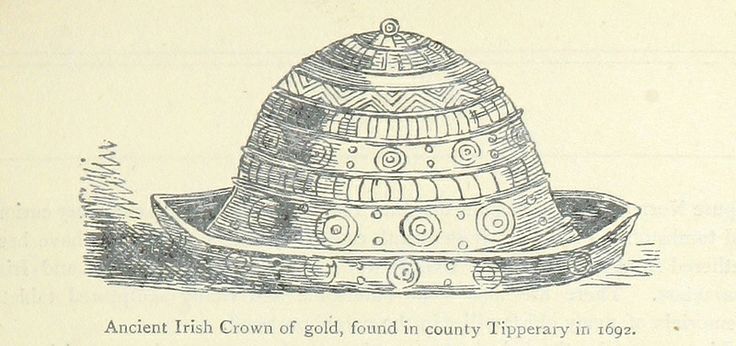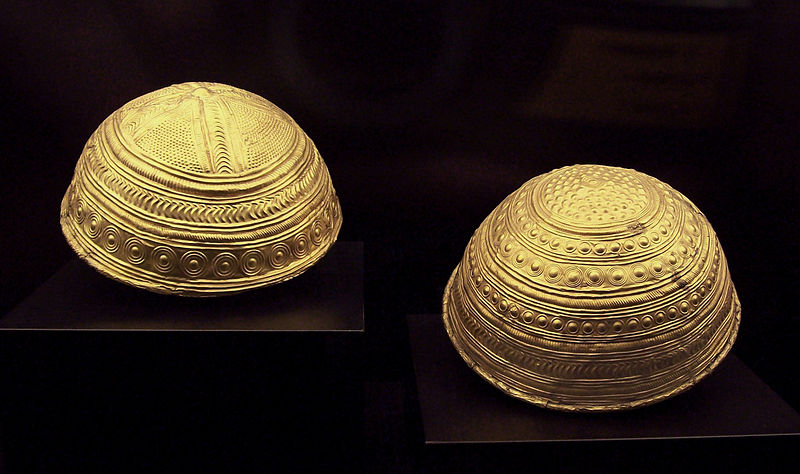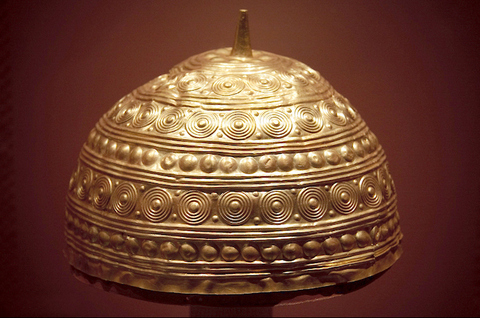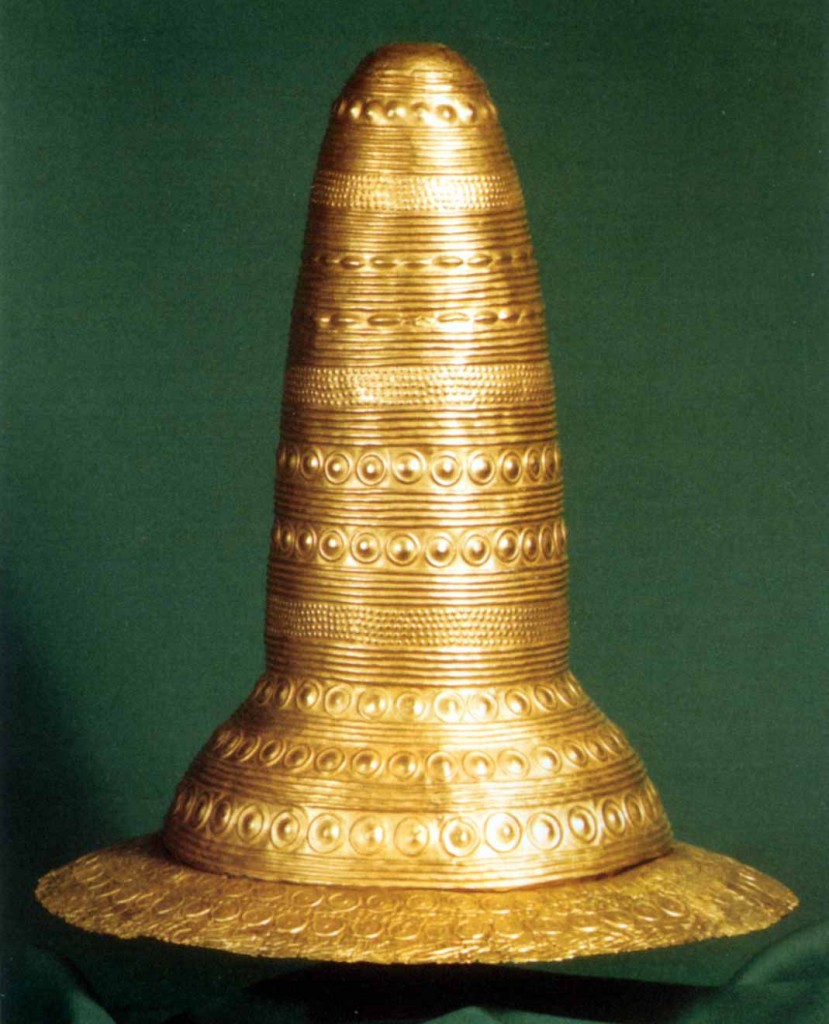
The Comerford Crown is striking gold artefact, whose origins probably lie in the Late Bronze Age. It was discovered in 1692 in a peat bog at Bearna Eile (The Devil’s Bit), Co. Tipperary. As the picture above shows, it was profusely decorated, in what was most likely repousse ornamentation. An extraordinary object, the crown must have created a considerable stir when found. It soon caught the eye of a Mr. Joseph Comerford, who purchased it and subsequently brought it to Châteaux de Anglure in Champagne, France, where he was then resident. Unfortunately, the crown went missing soon afterwards.

Parallels for this precious object can be found in continental Europe, where a small number of gold hats/vessels are recorded from Bronze Age contexts. In the northwest of the Iberian peninsula, for example, at least three gold hats or bowls have been recovered that are strikingly similar to the Comerford Crown. Fashioned out of carefully hammered gold, they are covered in repoussé decoration that is comparable to the Tipperary crown, especially the circular motifs and banded ornamentation.

Slightly further afield, in central Europe, a small number gold hats/vessels have also been discovered. They include eight gold ‘bowls’ from Eberswalde, Germany that date to the Late Bronze Age. These thin-walled vessels are profusely decorated and employ many of the motifs seen on the Comerford Crown.

Even more elaborate gold ‘hats’ are also known from Germany. These tall, conical shaped hats/vessels are fashioned out of sheet gold and appear to have originally adorned organic head dresses, which have since decomposed. Their unusual profile makes it unlikely that they were used as bowls, as does the shape of their openings, which are are oval rather than round, with diameters broadly equivalent to those of a human head. The are covered in decorative motifs and again circles and linear ornamentation dominate.

The Comerford Crown is not the only Bronze Age ‘hat’ recorded from Ireland and in the late 17th century a second gold crown/vessel was found nearby at the Bog of Cullen, Co. Tipperary. Known locally as the Golden Bog, due to the sheer quantity of artefacts recovered from its depths during the 17th and 18th centuries, this morass appears to have been an important ritual site during the Late Bronze Age. Unfortunately, very few of the objects found in the bog have survived to the present day and the gold ‘crown’ is no different. In 1744 it was purchased by a Limerick Jeweller, Joseph Kinshalloe, who melted down the artefact to produce 6 ounces worth of gold. Another gold ‘crown’, described rather unusually as shaped like a shell, was also discovered in Co. Limerick at Kilpeacon in 1821. Regrettably, this object was similarly melted down for bullion.
The original function of these elaborate gold objects remains uncertain. If they were indeed crowns, then they were probably worn in conjunction with an organic headdress or lining that has not survived. Most likely the possessions of high status individuals they were probably used during specific ceremonies or rituals. Another possibility is that some of the ‘hats’ adorned wooden statutes or totems that may have depicted local deities.
Conversely, it also has been argued that these precious items are not in fact crowns, but instead gold bowls/vessels. This is especially the case with some of the artefacts from the Eberswalde hoard, which appear too small to fit on a human head.
References
Eogan, G. 1981 ‘The gold Vessels of the Bronze Age in Ireland and Beyond’ in Proceedings of the Royal Irish Academy. Section C: Archaeology, Celtic Studies, History, Linguistics, Literature, Vol. 81C, pp. 345-382
Image Source for the Comerford Crown



Lovely. Have shared onto Facebook.
Thanks 🙂
Here’s a few more of those gold hats!
http://jauntingjen.com/2014/01/06/four-gold-hats-a-bronze-age-mystery/
Excellent post! I’d never encountered this artefact before. Though … bizarrely … I do have a picture of it on my wall … I just thought it was a fantastical representation of something ‘ancient’, rather than a real artefact. It’s a minor element in an early 19th c illustration called ‘Hibernian Male and Female Costume’
That’s gas Robert :). I stumbled across it on the British Museum’s Flickr stream. It was illustrated in an old 19th century book. I’d never seen it before, or even realised such an artefact existed during the European Bronze Age. Pity it went missing!
Colm, are you aware of any research regarding the embossing on these crowns/bowls?
It would be interesting to read about the ‘meanings’ of them; whether they represent, as mentioned briefly in your post , position/status symbols of the individual wearing/using them; are the impressions symbols or statements to or about the deity of the time period;where they military objects depicting level of command?
*********
When these objects were found in the 17th-18th century were they actual archeologist who found them who would understand the necessity of cataloging these finds, or would they have been local people who didn’t have the fore sight to save these items for archeological findings hence for the melting of them into bullion.
Bullion that may have been needed for warfare. And perhaps they were deemed ‘rewards’ of victory….
Bren
Hi Bren,
It’s impossible to be certain what they were really used for, we just don’t know. There is a suggestion that the symbols on some of the hats, especially the taller German examples, may represent moon and sun cycles. Again though, this impossible to prove. All the Irish examples were found by local people, just poor farmers cutting turf. Finding something something like a gold hat must have been akin to winning the lottery.It’s easy to see why they looked on them in monetary terms rather than for their archaeological value. It’s amazing really that any of them survived, considering.
Colm
Hi,
For what it is worth, the Comerford crown to which the article refers, was locally believed to be the skull cap or “crown” used by the O’Meachair Chieftan of Ikerrin (a barony to the north of Tipperary), who in later medieval times lived nearby at Clonakenny Castle.
Naturally the item predates the Gaelic chiefs by many centuries but this and another bronze age artefact – the Borrisnoe Collar which was also found in the same boglands in 1836 – were both believed to be the possessions of the local chief and/or were used in their customs. Early written accounts point to these traditions and support this view.
Thanks
Thanks for that extra information